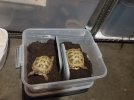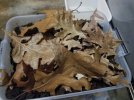Some of you may have been following mu other posts with the wind-down process. Last week, I still soaked the tortoises, and then set them under the light to bask for an hour so they were dried off, but then turned off their lights. They were no longer pooping during their soak, and spent most of the time sleeping.
I have been monitoring and adjusting the refrigerator. I adjusted the dial so that most of the time, my little digital probe thermometer read 4°C with a min of 2°C and max of 6°. I put some jugs of water into the fridge to help keep temps steady.
Once the refrigerator kept that safe temp range on its own consistently, I plugged in my Inkbird ITC-308 (available on Amazon), plugged the fridge plug into the 'cooling' outlet on the Inkbird, and taped the probe wire along the side, through the door seal, and stuck the probe into a small bin of dirt. Later I'll stick the probe into the tortoise dirt in the actual bin. The purpose of this is to add an extra layer of safety, to prevent the tortoises from freezing to death. I set the Inkbird as follows:
tS 5.5°C (you can also set it to 7.0)
Hd 3.0 °C
Cd 2.5 °C
AH 120 (this number doesn't matter, since you plug the fridge into the 'cooling' outlet
AL 2.5 °C
Pt 0
CA 0.0°C
CF C
This is for a Russian tortoise. A Greek or Hermans tortoise needs it to be slightly warmer, I think their range is 5-8 °C.
Yesterday, I weighed each tortoise, and recorded their weights in my tortoise notebook. I visually inspected each tortoise to make sure they didn't have any injuries, all noses were dry, eyes were bright (though grumpy). I had prepared latching plastic boxes by melting air holes all along the upper edge and also about 10 in the lid itself. I cut some random pieces of plastic (lids from plastic shoe boxes) into little partitions for the boxes, so the 2 tortoises in each box could have their own space. I made sure they each had enough space to turn around.
I put 1" of additive free topsoil into each bin, and placed the tortoises on top of that.

Then I gently poured more dirt on top, so that loosely piled, it reaches to 1" from the top. (Yes, one of them instantly tried to dig back out)

Onto this, I spread oak leaves. Other hardwood leaves such as maple or beech are fine as well, just make sure they are not moldy, and don't have a strong smell. They help keep the humidity of the substrate, while allowing air flow.

Then, I closed and latches the lids, and placed the boxes into the unheated portion of the cellar overnight, to start cooling. After 24-48 hrs there, I am moving the bins into the fridge.

Remember, the bins need to be small enough not to touch any of the inside walls of thw fridge. Otherwise, they could experience contact freeze, which would be deadly to the tortoises inside.
Note: Russian tortoises need fairly dry substrate to brumate in. Not bone dry, but not wet. After a night in slight coolness, there is a tiny bit of condensation on the inside walls of the bins, and that is fine. But unlike Greek tortoises or Hermans, you do not need to 'water' the dirt during brumation. The other difference is the colder temperature. Russian tortoises, in comparison to Greek and Hermanni require a colder temp range of 3-5°C (37-41°F). At warmer temps like 8°C Russians won't settle down, will keep burning calories, and you'll constantly hear them scraping in their boxes.
My Russian tortoises will stay in their brumation (reptile version of hibernation) from November 15 - March 15. I know it's hard to leave the tortoises alone for that long. I used to bother them by weighing them every week and checking if they still had reflexes... And then a few years later, weighing them once a month and checking reflexes. In the last two years, I only weighed them once in the final 2 weeks. Everyone had lost less than 2g, and came out of brumation healthy and active and with voracious appetites, so I quit bothering them. I know they are healthy going in, so I will trust their instincts and their ability to survive.
Even my captive bred juveniles made it very clear that their bodies are programmed to brumate during winter. A few of them dug down and aestivated this Summer for a few weeks, too. Because they are healthy as heck and rock solid, they get to brumate alongside the adults. I waited until they were over 200g.
Sleep sweet, little friends, see you next Spring!
I have been monitoring and adjusting the refrigerator. I adjusted the dial so that most of the time, my little digital probe thermometer read 4°C with a min of 2°C and max of 6°. I put some jugs of water into the fridge to help keep temps steady.
Once the refrigerator kept that safe temp range on its own consistently, I plugged in my Inkbird ITC-308 (available on Amazon), plugged the fridge plug into the 'cooling' outlet on the Inkbird, and taped the probe wire along the side, through the door seal, and stuck the probe into a small bin of dirt. Later I'll stick the probe into the tortoise dirt in the actual bin. The purpose of this is to add an extra layer of safety, to prevent the tortoises from freezing to death. I set the Inkbird as follows:
tS 5.5°C (you can also set it to 7.0)
Hd 3.0 °C
Cd 2.5 °C
AH 120 (this number doesn't matter, since you plug the fridge into the 'cooling' outlet
AL 2.5 °C
Pt 0
CA 0.0°C
CF C
This is for a Russian tortoise. A Greek or Hermans tortoise needs it to be slightly warmer, I think their range is 5-8 °C.
Yesterday, I weighed each tortoise, and recorded their weights in my tortoise notebook. I visually inspected each tortoise to make sure they didn't have any injuries, all noses were dry, eyes were bright (though grumpy). I had prepared latching plastic boxes by melting air holes all along the upper edge and also about 10 in the lid itself. I cut some random pieces of plastic (lids from plastic shoe boxes) into little partitions for the boxes, so the 2 tortoises in each box could have their own space. I made sure they each had enough space to turn around.
I put 1" of additive free topsoil into each bin, and placed the tortoises on top of that.

Then I gently poured more dirt on top, so that loosely piled, it reaches to 1" from the top. (Yes, one of them instantly tried to dig back out)

Onto this, I spread oak leaves. Other hardwood leaves such as maple or beech are fine as well, just make sure they are not moldy, and don't have a strong smell. They help keep the humidity of the substrate, while allowing air flow.

Then, I closed and latches the lids, and placed the boxes into the unheated portion of the cellar overnight, to start cooling. After 24-48 hrs there, I am moving the bins into the fridge.

Remember, the bins need to be small enough not to touch any of the inside walls of thw fridge. Otherwise, they could experience contact freeze, which would be deadly to the tortoises inside.
Note: Russian tortoises need fairly dry substrate to brumate in. Not bone dry, but not wet. After a night in slight coolness, there is a tiny bit of condensation on the inside walls of the bins, and that is fine. But unlike Greek tortoises or Hermans, you do not need to 'water' the dirt during brumation. The other difference is the colder temperature. Russian tortoises, in comparison to Greek and Hermanni require a colder temp range of 3-5°C (37-41°F). At warmer temps like 8°C Russians won't settle down, will keep burning calories, and you'll constantly hear them scraping in their boxes.
My Russian tortoises will stay in their brumation (reptile version of hibernation) from November 15 - March 15. I know it's hard to leave the tortoises alone for that long. I used to bother them by weighing them every week and checking if they still had reflexes... And then a few years later, weighing them once a month and checking reflexes. In the last two years, I only weighed them once in the final 2 weeks. Everyone had lost less than 2g, and came out of brumation healthy and active and with voracious appetites, so I quit bothering them. I know they are healthy going in, so I will trust their instincts and their ability to survive.
Even my captive bred juveniles made it very clear that their bodies are programmed to brumate during winter. A few of them dug down and aestivated this Summer for a few weeks, too. Because they are healthy as heck and rock solid, they get to brumate alongside the adults. I waited until they were over 200g.
Sleep sweet, little friends, see you next Spring!